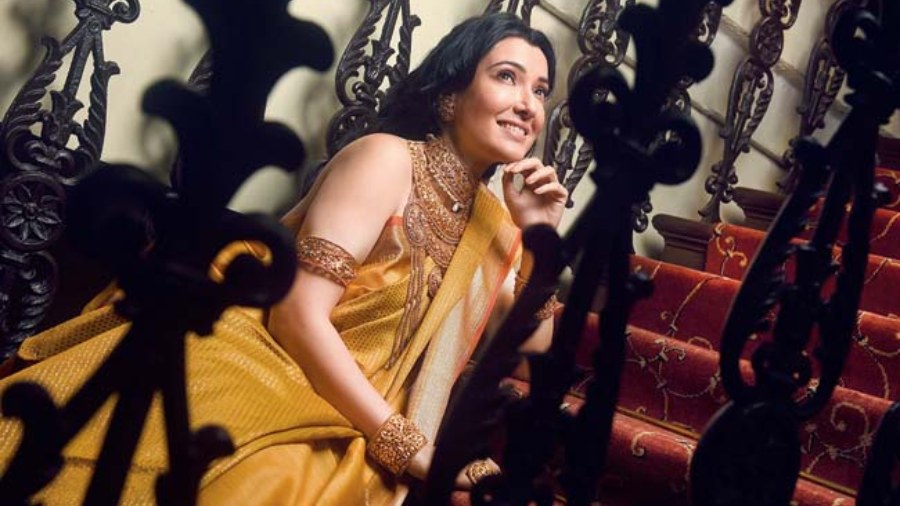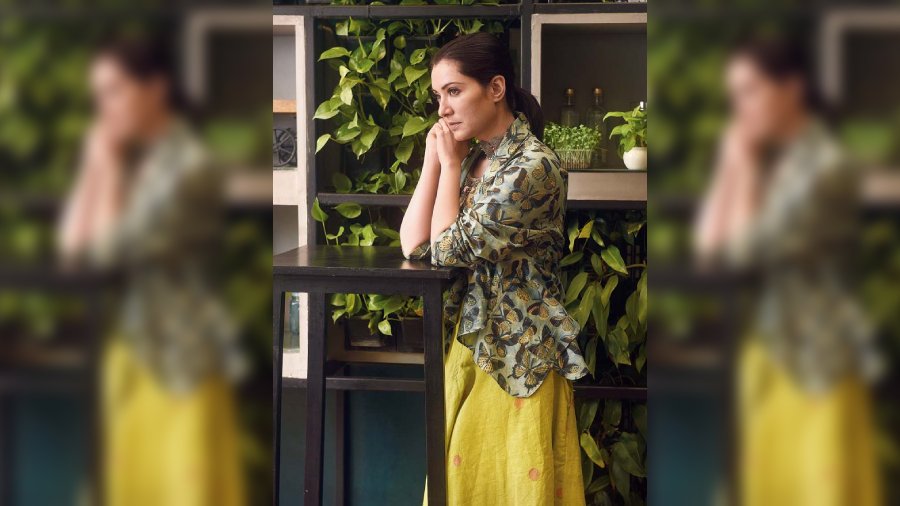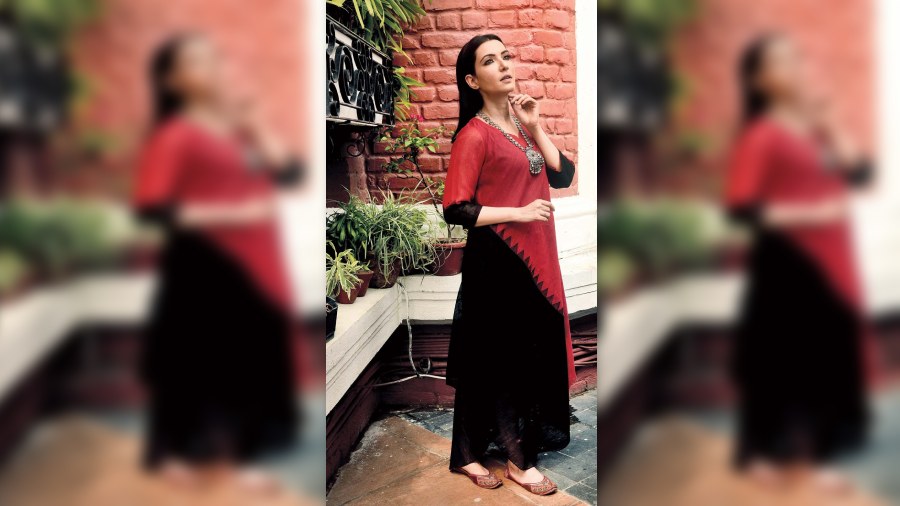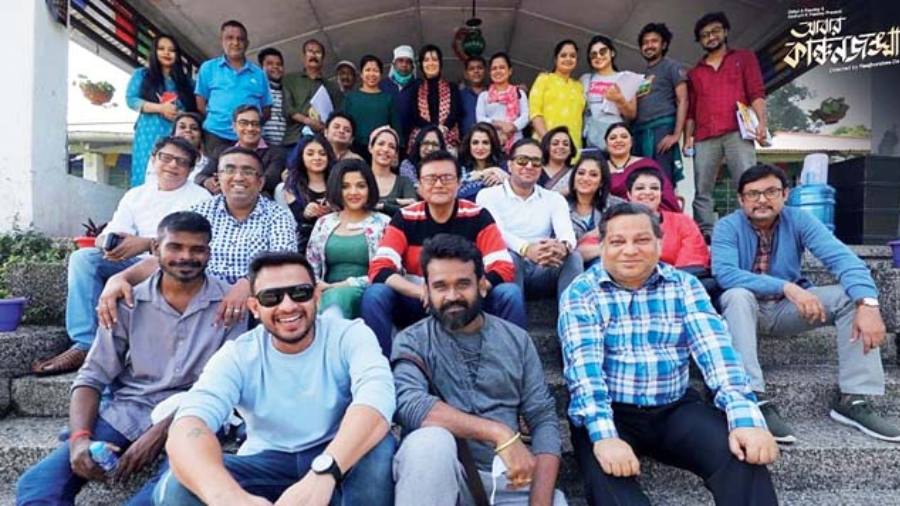Actress Arpita Chatterjee’s style statement has always been about gracefully interlacing the classic with the contemporary. So, when we planned a special Nava Varsha shoot with her, The Telegraph chose four styles, ditching the quintessential red-and-white, featuring the classic and contemporary looks apt for the season and this Poila Baisakh. Arpita’s work life is a tale of two cities and Nava Varsha celebrations are rare for her, but Kolkata has her heart. And Kolkatans have her in their hearts, too, for her screen presence and performances. Essaying a beautiful role in her recent release Abbar Kanchanjangha, she has won the hearts of the audience yet again. Here’s The Telegraph’s Nava Varsha lookbook with the actress and a heart-to-heart chat about Kolkata, films and more:
As we step into a new year what is that one wish you would like to make?
My wish has always been to see all my work in progress get completed with a success story.
How do you usually like to spend Poila Baisakh if not working?
Usually, it is a working day for me. Because apart from my acting and performance art, I run my production company in Delhi. In Delhi, there is no holiday on Poila Baisakh unless it falls on a Sunday. As an exception, if I am in Kolkata and if my son (Trishanjit) is at home, then some special cuisine or Bengali cuisine is prepared. The ultimate Poila Baisakh celebration for me is staying at home and spending quality time with my son.
Is there a particular time or festivity when you miss being in Kolkata or you make it a point to come to the city?
Coming to Kolkata, for me, depends on two things — one is for work and the other is for my son. Whenever he comes, I come back.
Now that you have been juggling between two cities, what place does Kolkata hold in your heart?
(Laughs) Kolkata will always be a favourite place for me to be in. Nothing compares to it. The city has its own charm and it is very different from Delhi. Not getting into whether the difference is good, bad or ugly. But given a choice between where I want to stay, I will definitely say Kolkata.
Both your 2022 releases (Abar Bochhor Koori Pore and Abbar Kanchanjangha) are set in the hills. How was your shooting experience post the pandemic?
Both the shooting happened in between the pandemic. Abbar Kanchanjangha happened between the first and second waves, so that was a different psychological or emotional experience. After the pandemic, when the shooting started, it was a mixed feeling for us. We were happy that everything was getting back to normal but the fear was also there. For Abar Bochhor Koori Pore, it was the same thing. It wasn’t easy as everybody’s vaccination was not completed. It was challenging. Overall, getting back to work and seeing the world come back to normal was definitely a pleasurable and hopeful experience. It gave me a positive feeling.
You have had back-to-back releases since 2021. Did you manage to take some time off for a vacay? Do you have any travel plans?
It is difficult to take any vacation. Either I am in Delhi or Kolkata, so something or the other keeps coming. But, of course, taking some time off for vacation is very important for everyone. Let’s see. Until now I couldn’t manage, it is there in my mind. I hope I will be able to take some time off for my vacation.
You juggle so many different roles. What keeps you going in a day?
It is just the planning. I am not the only one, there are many who multitask. This is nothing new to me. I have been doing this for quite some time, now I am used to it. Delhi-Kolkata has become like a local journey for me. It is just a couple of hours’ flight. I don’t need to carry any luggage! (Laughs) In both places, my set-up is ready. I just carry myself (Laughs). So planning is very important. Otherwise, everything will go haywire.
You essayed the character of Semanti so beautifully on screen. What drew you to the script of Abbar Kanchanjangha?
I consider four elements before saying yes to any of my projects — story, script, character and my equation with the director. For Abbar Kanchanjangha also, these four things were the criteria and when I can tick all these boxes, I agree to do the work. For both my releases, Abbar Kanchanjangha and Abar Bochhor Koori Pore, all four elements were very positive for me.
Were there any challenges in portraying the role?
Every time it is challenging. Being a professional actress, I am expected to play different kinds of roles and I love taking that challenge rather than being in my comfort zone. For me, it is a pleasurable experience.
Do you relate to the character of Semanti in any way?
Being a professional actress, I never connect my character to the individual I am. I don’t mix up these two. But when I play a character, I do one thing. I am a very good observer. I keep observing various characteristics and mannerisms of people in general and create a bank in my memory. Whenever I get a character, I take references from there. Because the stories we act in are our stories, stories of the society… nothing is from outside of this world.
Was there any second thought about being a part of such a huge cast?
Not at all.
What was your experience of being directed by Raajhorshee De (director of Abbar Kanchanjangha)?
I think this is my third or fourth film with him. He is a known person to me personally and as a director. When someone is doing a third or fourth project with someone then there is a mutual liking, which is why the director is also repeating me, and I am also eager to work with him again and again.
You had mentioned once that your script choosing process had changed after Ekti Tarar Khonje. How do you choose your roles now?
When I started my second innings as an actor... these terms keep coming up as far as I am concerned... third innings, fourth innings… but actually it was just one official break that I took after my pregnancy to look after my kid. Those six years’ gap was a conscious decision. After that, I never took any break, but for that people tend to think why they can’t see me more often in films. That’s not the reality. What I realised from Ekti Tarar Khonje until now is that the storytelling format has changed. The packaging and presentation of content have changed, and technology has changed. A lot of changes have happened since the time I used to do commercial films. These days content is the main deciding factor. This is why I focus on the story to say yes to any project.
Doesn’t OTT interest you?
I haven’t done anything in OTT so far. I am waiting for a good script, content and character, where it will be justified for me to debut on this platform.
What are your upcoming releases?
There is another film called Hridpindo by Shieladitya Moulik, which got postponed due to the pandemic. The back-to-back releases now were planned two years back. All that is happening now.
Classy in Classic:

The de-glam and delicately beautiful look of Binodoni from Chokher Bali was our chosen look for creating a classic Bengali look for this Poila Baisakh. Arpita Chatterjee pulled off the subtle look with her charming aura in this tussore mustard yellow Benarasi from Glamour Designer Boutique, crafted in Benaras, with antique copper zari border and buta work all over. Heritage gold jewellery from B. Sirkar Johuree featuring typical Bangla naksha studded with stones, natural make-up in shades of golden-brown and nude, and the hair left open with a soft texture enhance the look.
Easy-breezy and Fresh:

A comfy and soft dewy look for Nava Varsha morning from Aranya. The complementing pastels and print add the summer vibe to the look. A lime-green high-waist bias-cut skirt in Bengal’s jamdani fabric for the classic appeal, detailed with round butis and pockets for convenience. It is paired with a vegetable-dyed dabu-printed peplum shrug. Matte base, subdued eyes, the hair tied into a pony and a statement silver neckpiece from Aranya complete the minimal morning look.
Smart and Sassy:

Arpita cut a spiffy frame in this asymmetrical, dual-colour interwoven cotton dress from Glamour Designer Boutique, detailed with jamdani temple design, perfect for a comfy Poila Baisakh evening outing with friends. The eyes accentuated with kohl, nude lips, sleek hair and silver neckpiece from Aranya complement the bold colour palette of the look.
Chic Fusion:

Draped in an Indo-western style with a contemporary appeal, the 180-count cotton handwoven indigo-colour sari with jamdani motif, from Parama, is paired with a contrasting grey relaxed-fit jamdani jacket from Aranya, designed like a layered peplum. It is worn like a tie-knot top to accentuate the style. Layered silver jewellery from Aranya, kohl-lined eyes, natural blush and mascara add to the summer evening look.
Pictures: Pabitra Das
Styling: Anupam Chatterjee
Hair and Make-up: Aniruddha Chakladar
Location: The Astor
